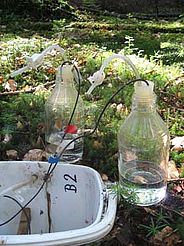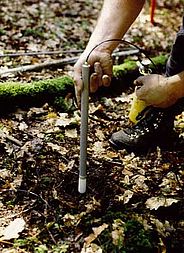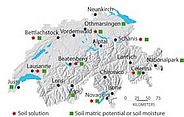Soil solution chemistry and soil water availability in long-term monitoring forest plots (LWF)
Daniel Christen
Beat Frey
Noureddine Hajjar
Jörg Luster
Maria Schmitt Oehler
Flurin Sutter
Anne Thimonier Rickenmann
Peter Waldner
Lorenz Walthert
Stephan Zimmermann
Alois Zürcher
2001 - 2038



The chemistry of soil solution and the availability of soil water for plants have been monitored since 1997 or later in seven forest ecosystems throughout Switzerland. This project aims to assess the soil response to atmospheric pollution (acidifying substances and nitrogen) and to climate change. This project is part of the Swiss Long-term Forest ecosystem Research project (LWF).
Environmental stresses to forest soils
Atmospheric deposition of acidifying substances and elevated input of nitrogen might alter the soil functions and represent potential stress factors for forest ecosystems. Acid deposition might accelerate soil acidification, leading to a decrease in soil pH, the leaching of nutrients and/or the mobilization of toxic aluminum for sensitive plants. Increased nitrogen concentrations in the soil solution may lead to nutrient imbalances for trees and changes in the composition of ground vegetation. Large nitrate leaching below the root zone might also threaten the quality of the ground- and surface-water.
Climatic changes, such as temperature increase and/or a modification in the precipitation pattern, might have an effect on the forest ecosystem (e.g. tree growth) and induce increased drought stress for the trees. The long-term measurement of the soil water availability to plants in the root zone provides useful information about how drought-sensitive the forest stands are. The measurement of the soil water suction combined with the characterization of the soil physical properties allows the modeling of water fluxes in the root zone and the calculation of leaching fluxes below the root zone. These data are particularly useful for the assessment of element budget in the forest ecosystem.
Objectives
The main objectives and questions of this project are:
- to study the long-term trend of the soil solution chemistry in response to atmospheric deposition of acidifying substances. Do nutrient leaching and aluminum represent a potential risk for sensitive plants?
- to identify the impact of N-deposition on the chemistry of the soil solution (nitrate leaching below the root zone?). In cooperation with the others teams involved in the LWF project, to identify the potential factors regulating the nitrate production (N deposition, litter quality, soil type, climate).
- to estimate the soil water availability to plants to identify potential water stress. Can climatic changes cause a change in the water availability to trees (increasing drought stress for instance during the summer)?
Methods
The sampling and the analytical methods used for the soil solution monitoring were selected on the basis of recommendations of expert groups from the Forest Soil Coordinating Center of the ICP Forests program (ICP Forests manuals) and experts at the WSL. Soil solution is collected fortnightly in 7 long-term monitoring plots since 1997 or later (see map). The chemistry of the soil solution is monitored by sampling soil solution below the litter layer with gravitation plates and at three lower depths (15, 50 and 80cm) with tension lysimeters (ceramic cups). Vacuum (500 hPa) is applied to the suction cups before each sampling. In each plot, soil solution is collected at 8 sampling points and then pooled in the laboratory for chemical analysis. After filtration, samples are analyzed for pH, electrical conductivity, dissolved organic carbon (DOC), dissolved organic nitrogen (DON), major cations and anions. To assess the acidification status of the soil solution and the associated ecological risks for sensitive plants, the molar ratio of base cations (sum of the molar concentrations of Ca, Mg and K) to aluminum (BC/Al) in the soil solution is calculated.
The plant-available soil water has been estimated in 10 long-term monitoring plots (see map) by measuring the soil water suction with water-filled tensiometers at three or four different depths since 1998 or 2000. The tensiometers are read manually fortnightly. At a dry forest plot (Visp), the volumetric soil water content has been measured since 2002 with TDR probes at three different depths.
The water balance in the studied forest ecosystems is modeled with different types of models to simulate potential and actual transpiration (PT and AT), drainage and water stress (AT/PT). Measurements of the soil moisture or the soil matric potential at different soil depths are used to calibrate and validate the simulated water fluxes. The simulated water fluxes are used to estimate element fluxes through the soil.
A national and international project
This project is a part of the Swiss Long-term Forest Ecosystem Research project (LWF), including a network of 17 intensive monitoring forest plots (Level II plots) throughout Switzerland. The project was launched in the mid-1990's to improve our understanding of processes occurring in the forest ecosystem and to assess how the forest ecosystem reacts to environmental stresses (natural and anthropogenic) in both the short- and the long-term.
This project meets the aims of the International Co-operative Programme on the Assessment and Monitoring of Air pollution Effects on Forests (ICP Forests), which was implemented under the convention on Long-range Transboundary Air Pollution of the UN/ECE. The intensive monitoring level comprises around 800 Level II plots in selected forest ecosystems in Europe.
Publications
Graf Pannatier E., Dobbertin, M., Heim, A., Schmitt, M., Thimonier, A., Waldner, P., Frey, B. (2012) Response of carbon fluxes to the 2003 heat wave and drought in three mature forests in Switzerland. Biogeochemistry 107: 295-317
Graf Pannatier, E., Thimonier, A., Schmitt, M., Waldner, P., Walthert, L., (2012): Impact des dépôts atmosphériques acides sur l'eau des sols forestiers. Journal Forestier Suisse 9: 363-373
Thimonier, A., Graf Pannatier, E., Schmitt, M., Waldner, P., Schleppi, P., Braun, S. (2012): Dépôts atmosphrériques azotés et leurs effets en forêt: un bilan des sites d'observation à long terme, Journal Forestier Suisse 9: 3056-3062
Graf Pannatier, E., Thimonier, A., Schmitt, M., Walthert, L., Waldner, P. (2011) A decade of monitoring at Swiss Long-Term Forest Ecosystem Research (LWF) sites: can we observe trends in atmospheric acid deposition and in soil solution acidity? Environmental Monitoring and Assessment 174:3-30
Thimonier, A., Graf Pannatier, E., Schmitt, M., Waldner, P., Walthert, L., Schleppi, P., Dobbertin, M., Kräuchi, N. (2010): Does the exceedance of critical loads for nitrogen alter the nutrient status of trees, nitrate leaching and crown condition at Swiss Long-term Forest Ecosystem Research (LWF) sites? European Journal of Forest Research 129:443-461
Graf Pannatier E., Dobbertin, M., Schmitt, M., Thimonier A., Waldner P (2009) L'eau des sols forestiers: un milieu sensible aux changements. Forum für Wissen 2009, WSL, Birmensdorf
Graf Pannatier, E., Schmitt, M., Thimonier, A., Waldner, P., Walthert, P. & Blaser, P. (2006): Monitoring de la composition chimique de l’eau dans les sols forestiers : un outil pour évaluer leur acidification. Bulletin BGS 29, 59-64.
Waldner P., Schaub M., Graf Pannatier E., Schmitt M., Thimonier A., Walthert L. 2007. Atmospheric Deposition and ozone levels in Swiss forests:Are critical values exceeded? Environmental Monitoring and Assessment, 128, 5-17.
Graf Pannatier, E., Luster, J., Zimmermann, S and Blaser, P. 2005. Acidification of soil solution in a chestnut forest stand in southern Switzerland: are there signs of recovery? Environmental Science & Technology, 39, 7761-7767.
Graf Pannatier, E., Luster, J., Zimmermann, S and Blaser, P. 2005. Monitoring of water chemistry in forest soils: an indicator for acidification. Chimia, 59(1), 989.
Graf Pannatier, E. Walthert, L and Blaser, P. 2004. Solution chemistry in acid forest soils: Are the BC:Al ratios as critical as expected in Switzerland. Journal of Plant Nutrition and Soil Science, 167, 160-168.
Dobbertin, M., Bernhard, L., Graf Pannatier, E., Schmitt, M. Thimonier A., Walthert, L. 2001. Langfristige Waldökosystem-Forschung in Graubünden. Bündnerwald 2, 68-70